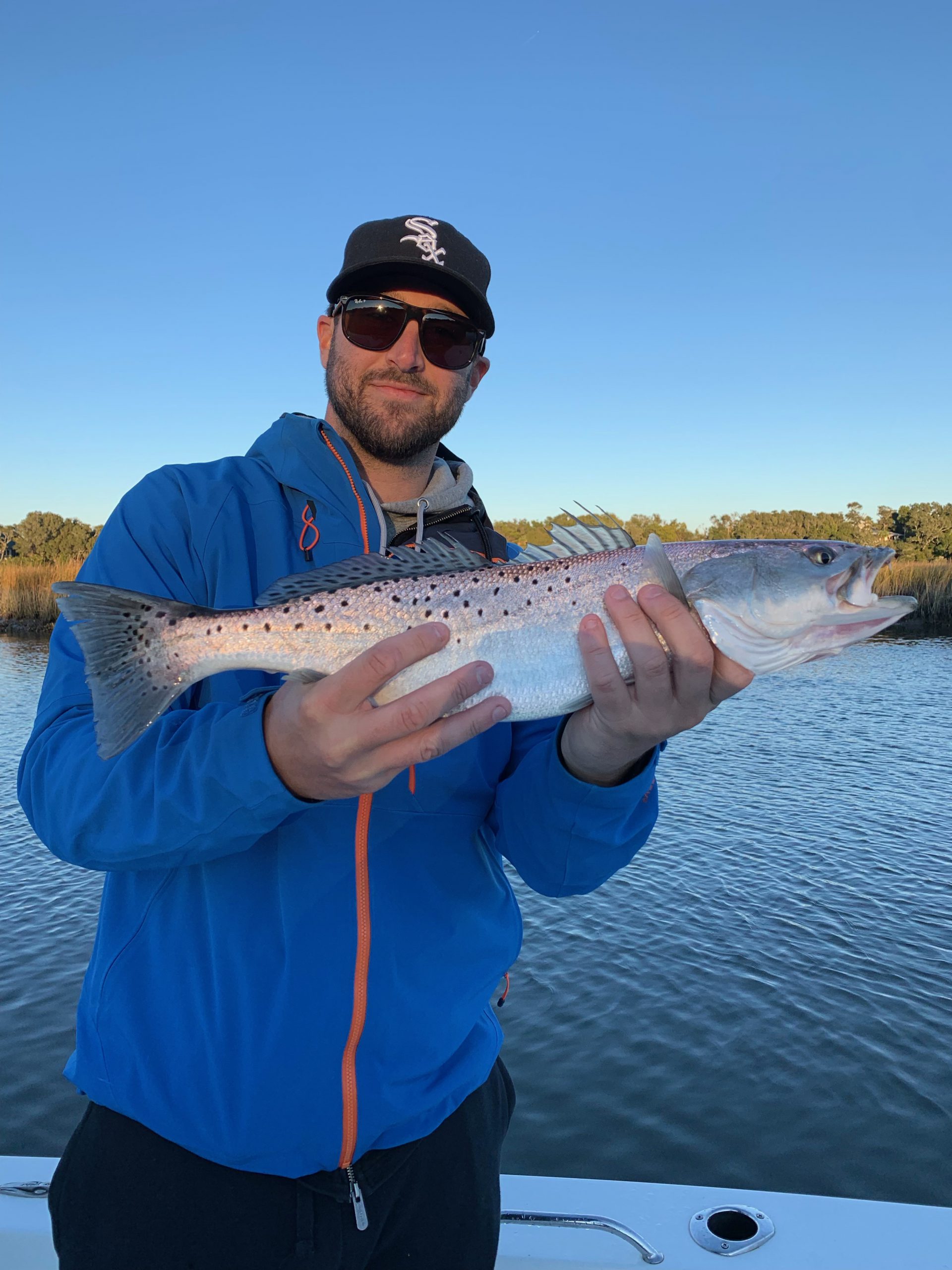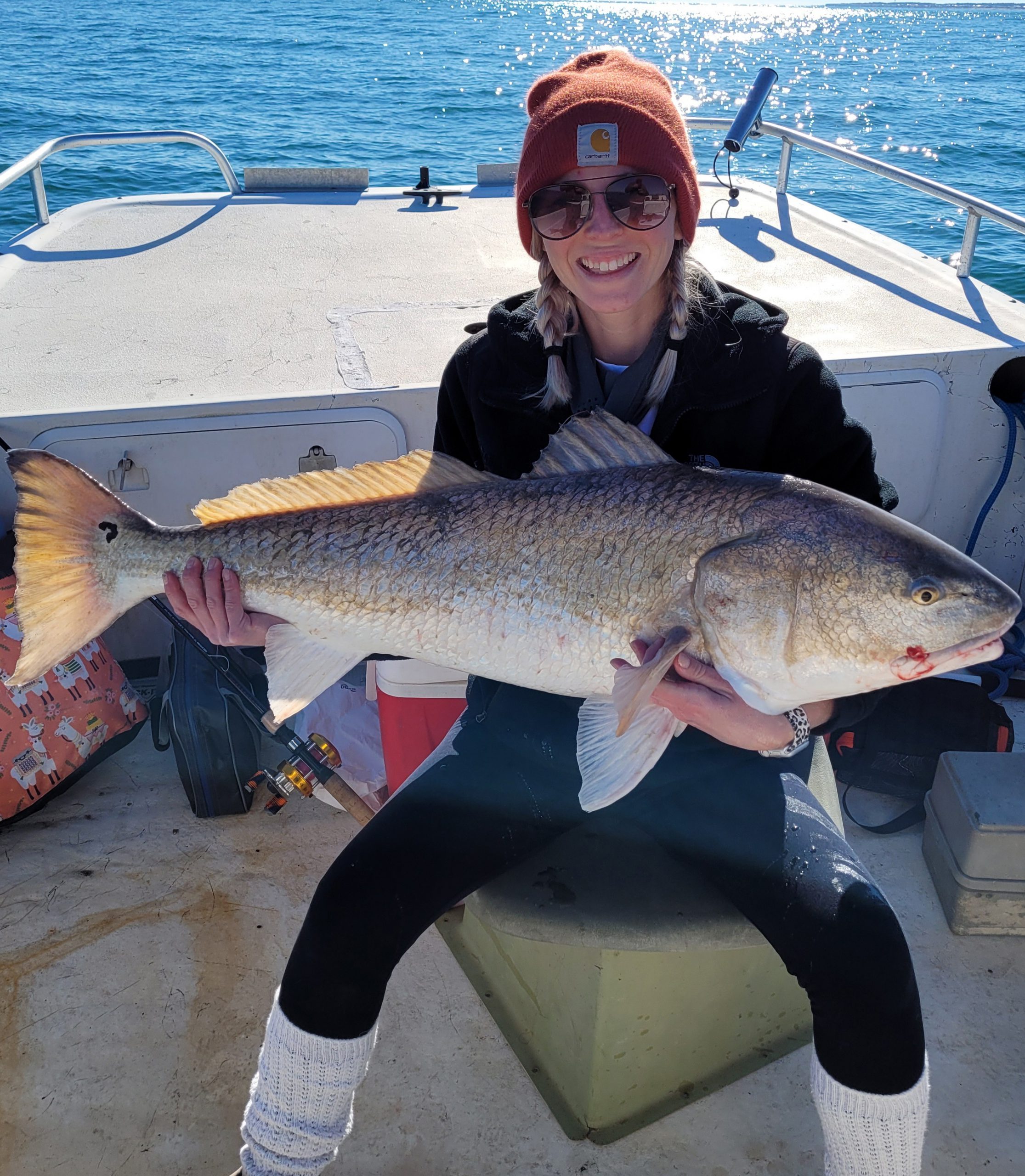Carolina Beach – March 2022
Andrew, of Island Tackle and Hardware, reports that surf anglers have been catching some early season whiting as they wait for warmer water temperatures to push in.
Red drum and scattered black drum are being caught with shrimp fished around deeper ICW docks. Rigging the shrimp on light weight jig heads is another setup that can produce some of these inshore bites.
Speckled trout fishing has been hit or miss as anglers look for warmer water conditions to move the schools out of their winter holdover areas.
Not too many anglers are running off the beach to fish. In the coming weeks, Atlantic bonito should be moving into the area and can help persuade anglers to take advantage of mild weather windows.

Jeff Ferrell, of Wilmington, caught this 23″ speckled trout on live shrimp while fishing the lower Cape Fear River. He was fishing with Capt. Christian Wolfe of Seahawk Inshore Fishing Charters.
Christian, of Seahawk Inshore Fishing Charters, reports that inshore anglers are finding some red and black drum still hanging around inshore.
Black drum will begin showing in even better numbers after some stable, warmer weather patterns start showing. Targeting areas of shelly bottoms with drop-offs or hard structures with shrimp will produce some strikes.
Red drum are feeding in these same areas of hard bottom. In addition to shrimp, live mud minnows also work great for these early season redfish. Anglers fishing artificial soft plastics will also have some success, with the scented baits by Gulp or Z-Man working best.
Luke, of Spot On Charters, reports that anglers are looking for pre-spawn speckled trout action to start firing up in March. There is still plenty of cool water around, so anglers will find small baits that fall slower will entice more strikes from lethargic fish looking for a bait they can easily metabolize. MirrOlure MR-17s are a great option under these conditions.
Some anglers are finding good redfish action while scouting schools in the gin-clear waters behind Bald Head Island. Smaller, lightly-weighted soft plastics have been working best to get strikes and not spook the schools.
Mason, of Grand Slam Fishing Charters, reports that inshore fishing in the lower Cape Fear is slowly starting to improve after a cold winter. March starts to see water temperatures hover around the mid-50s which gets these fish out of their lethargic patterns.
Red drum will mostly be found by anglers targeting the backs of creeks where water temperatures tend to be warmer. Look for deep holes (4-8’ range) during lower tide cycles that have plenty of shells along the bottom. Smaller 3” Gulp shrimp or jerk shads in natural color patterns fished on lighter-weight jig heads tend to work great under these conditions. Anglers will also find success while targeting these holes with Carolina-rigged dead shrimp and mud minnows.
Black drum will be in similar areas, with mostly dead shrimp on jig heads or Carolina rigs working best.
Speckled trout fishing will be picking up with the rising water temperatures. Target areas with current seams and breaks in the 6-10’ depth range. For trout fishing, structure is key. Look for rocks, oyster beds, and docks. Most importantly, fishing a moving tide raises your chances of success. These early season trout will always fall for a live shrimp (if they are available).
Towards the end of the month, look for Virginia mullet to start showing up in the shipping channel outside Bald Head Island. Double bottom rigs with dead shrimp work great when fishing the 20’ depth areas.

Alyssa Rackley, of Wilmington, caught this 41″ red drum while jigging for trout near Carolina Beach.
Rod, of OnMyWay Fishing Charters, reports that black sea bass fishing has been great for anglers getting out to structures in the 12-22 nautical mile range. Good-sized vermilion snapper and triggerfish are also mixed in around this same range.
A lot of American red snapper are holding on offshore structures, so it is key to have a descending device handy to keep these breeding-sized fish healthy.
Anglers are keeping a close eye on water temperatures for that 57 degree and above mark for Atlantic bonito to start showing up off the beach. The 2-5 nautical mile range will be best as these schools push through, and the 60-65 degree range typically produces the prime time action.
Mixed in with the bonito will be the first push of big spanish mackerel. This happens usually around the end of March going into April.
Anglers running to the break are finding great wahoo fishing over hard bottom and ledges from 130-180’+. Some blackfin tuna are also mixed in with the trolling action.
King mackerel will start showing up offshore about the time you see an edge of 70-degree water forming on the charts.
Bryan, of Kure Beach Pier, reports that water temperatures are still cool and just starting to get into a zone to kick off the bite.
Whiting should be showing up anytime in good numbers for anglers wanting to bottom fish.
